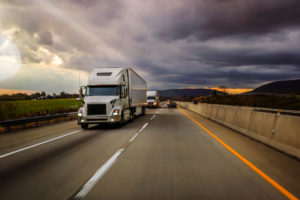By Thomas Black, Bloomberg
After lumbering through a gravel parking lot like a big blue bull, one of Aurora Innovation Inc.’s self-driving truck prototypes took a wide right turn onto a frontage road near Dallas. The steering wheel spun through the half-clasped hands of its human operator, whose touch may not be needed much longer.
Fittingly for Texas, these Peterbilts are adorned with a sensor display above the windshield that looks much like a set of longhorns. This was the beginning of a 28-mile jaunt up and down Interstate 45 toward Houston in a truck with a computer for a brain, and cameras, radar and lidar sensors for eyes, capturing objects more than 400 meters (437 yards) out in all directions.
The stakes for test drives like this one are incredibly high for the future of freight. If Aurora and other self-driving startups, including Alphabet Inc.’s Waymo, can convince customers and the public that large trucks can be automated safely, the potential efficiency gains are massive. The technology would help ease an unprecedented driver shortage, especially for long hauls that keep truckers away from home for weeks. More importantly, $150,000 big rigs that carry cargo will be able to roll around the clock, dramatically boosting utilization.
Aurora has designed and configured the hardware and software it will use to launch a service toward the end of next year in which roughly 20 trucks will ply highways without a human on board. “We’re now in the phase where we are doing the final refinements and the validation system-wide,” Sterling Anderson, the company’s co-founder and chief product officer, said in an interview just south of Dallas.
Aurora is starting in the Lone Star state for a few reasons. Texas is the US’s largest truck freight market and has long, sometimes very boring, stretches of freeway. Its interstate highway network boasts almost a third more miles than second-ranked California.
Texas also has some quirks that are helping teach Aurora’s system how to deal with unexpected scenarios. One is the incessant building and repairing of roads, resulting in 3,100 construction sites statewide, including 40 or so on Aurora’s route between Fort Worth and El Paso, Anderson said. There’s also the Texas U-turn, the horseshoe-shaped turnabouts at underpasses below major highways in cities and rural areas alike.
“Any Texas U-turn is going be a slightly different situation on account of who’s around you and what they’re doing,” said Anderson, the former head of Tesla Inc.’s Autopilot. “It’s tricky from humans, too.”
It took about a month for Aurora’s sensors and software to master the Texas U-turn, which allows vehicles to reverse course on a highway without hitting a stoplight. The maneuver requires the autonomous truck to yield to traffic coming at it from multiple sides and part of the methodical learning Aurora’s computer does with each test run.
So far, it’s working. Human operators who sit with hands poised to grab the wheel aren’t having to preemptively disengage the self-driving system as often for situations it’s not yet been trained to handle. The ability to navigate through constructions sites has improved dramatically, Anderson said. Aurora, whose other co-founder Chris Urmson used to lead Google’s self-driving program, declined to offer detailed metrics. Unlike California, Texas doesn’t require companies to publicly report the number of times their human test drivers disengage the autonomous-driving systems they’re testing on roadways.
The potential savings arising from commercialization of this technology has attracted customers including FedEx Corp. and trucker Werner Enterprises Inc.Aurora’s marquee investors include Toyota Motor Corp., Amazon.com Inc. and Uber Technologies Inc., which sold its driverless business to Aurora in 2020.
Safety will be paramount to Aurora’s success. Although there are more than 4,500 fatal accidents involving large trucks and buses each year in the US, with most caused by human error, any such incident with a driverless vehicle would be a major setback to the autonomous technology. In 2018, an Uber self-driving prototype vehicle hit and killed a pedestrian in Tempe, Arizona. The company suspended road testing for months and was rebuked by the National Transportation Safety Board.
For all the risk, the productivity gains from safely moving freight with autonomous trucks would reverberate across the shipping industry. The technology would unleash a “complete transformation of the logistics landscape,” said Steve Viscelli, a University of Pennsylvania sociologist who studies trucking and labor markets and is on Aurora’s advisory board.
Trucks are limited to moving as much as drivers can, which is oftenlimited to eight hours a day or less. In an industry shaped by Sam Walton’s innovation of locating Walmart Inc. stores no farther from a distribution center than a truck driver could reach roundtrip in a day, the range of autonomous trucks may affect a company’s decisions on locating distribution centers and how many it needs, Viscelli said.
Autonomous trucks also could alleviate problems such as drivers sitting around waiting to be loaded or unloaded, or hunting for a place to park. These issues — along with being away from home for long stretches — make it difficult to hire and retain long-haul truckers.
“We get a much more efficient trucking industry,” Viscelli said. “What’s really going to change is that greater asset utilization.”
During the test run near Dallas, the truck’s computer recognized a truck parked on the shoulder of the highway. The driverless rig would normally change lanes to give space for the stopped vehicle, but the system detected a pickup coming up fast on the left impeding Aurora’s truck from changing lanes. The autonomous rig instead slowed down as required by law, then sped up after the shoulder cleared.
On the way back to the Aurora terminal, the Peterbilt came to a halt at a busy four-way stop. The truck waited for one vehicle to proceed, then lurched forward to claim its turn to go. When no other vehicle moved, the truck made its turn, the steering wheel spinning by itself, and headed up the road.

